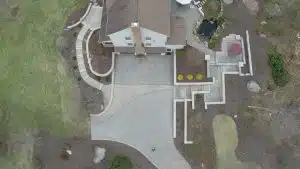What a great idea!
How One Landscape Professional Puts Drones to Use
FROM TURFMAGAZINE.COM
JENNIFER KING — MAY 31, 2017

Tom Gardocki, who is known as The Dirt Ninja on YouTube, uses drones for his father’s Interstate Landscape Co. for two main purposes: marketing and surveying projects.
“You can use it to take before pictures, because when you’re doing a design, you do the design from directly overhead to do the layout and dimensions,” he says. “So these pictures from straight up above you can’t even get from a ladder. Then the designer can use that to create the design.”
Gardocki says that sometimes even using the drone just 30 to 50 feet up can give a project a different perspective. Any higher than that and you can lose some detail about the topography. “You lose the pitches and grades; everything looks flat as you get higher,” he says. Even when you’re up 100 feet, you lose depth perceptions so you can’t really tell what’s going on — like retaining walls or a fire pit, you can’t really tell what it is.”
Undoubtedly, the most popular use for drones is marketing because showing clients pictures and videos from the drone gives them a different perspective they can’t get otherwise.
“I find going less than 50 feet to get that little different perspective, that little bit higher, different angle — you can tell that it’s only 30 feet in the air, but it gives you that little different perspective of the job site.”
He adds that while Interstate Landscape is a hardscape company and doesn’t do maintenance work, he can see where drones could be useful for surveying potential problems in large lawns or inspecting the tops of trees more carefully. Gardocki has used the drone to look at gutters and inspect roofs — it’s much safer than using ladders.
And the safety aspect of drone use is something to consider. Gardocki provides these helpful tips:
If your drone weighs more than a half pound, even if it’s just for hobby use, register it with the FAA. He said the cost is only $5, but if you don’t register it and you crash it and are held responsible, the fine may be as much as $27,000.
Gardocki uses the DJI Phantom 3+ Professional and recommends buying a drone with an integrated camera mounted on a gimbal. “It keeps the camera steady and level, so if the drone is tilted forward, it automatically levels the camera and keeps a steady shot.” This style drone may run about $1,000, but it’s worth the investment to have the camera held steady, he says.
Finally, always get permission from your client before using the drone. “You’ve got to be smart about it,” Gardocki says. “I always get permission from the customer to fly on the property before I do it, and I won’t fly it far away — I’ll stay within their property bounds.
“There are a lot of people who don’t like them — drones are really vilified in the news, so people can be really apprehensive of them, but I’ve never had anyone tell me no, as long as I ask.”

